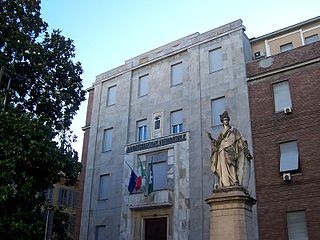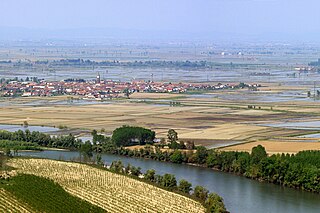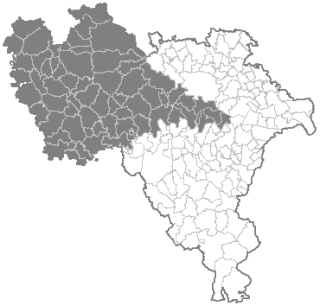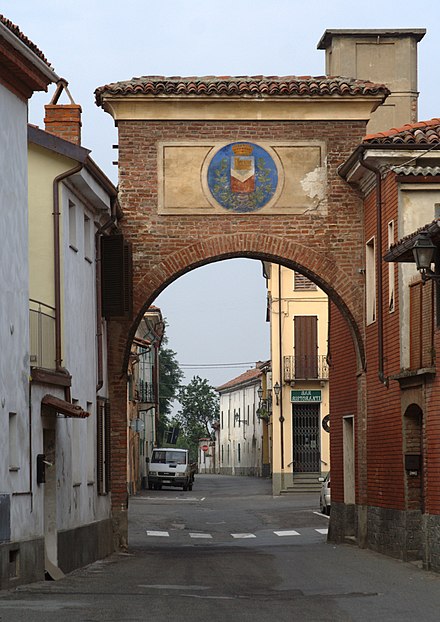
Piedmont is a region in northwest Italy, one of the 20 regions of the country. It borders the Liguria region to the south, the Lombardy and Emilia-Romagna regions to the east and the Aosta Valley region to the northwest; it also borders Switzerland to the northeast and France to the west. It has an area of 25,402 square kilometres (9,808 sq mi) and a population of 4,377,941 as of 30 November 2017. The capital of Piedmont is Turin.

Lombardy is one of the twenty administrative regions of Italy, in the northwest of the country, with an area of 23,844 square kilometres (9,206 sq mi). About 10 million people, forming one-sixth of Italy's population, live in Lombardy and about a fifth of Italy's GDP is produced in the region, making it the most populous and richest region in the country and one of the richest regions in Europe. Milan, Lombardy's capital, is the second-largest city and the largest metropolitan area in Italy.

Pavia is a town and comune of south-western Lombardy in northern Italy, 35 kilometres south of Milan on the lower Ticino river near its confluence with the Po. It has a population of c. 73,086,. The city was the capital of the Kingdom of the Lombards from 572 to 774.

Ticinum was an ancient city of Gallia Transpadana, founded on the banks of the river of the same name a little way above its confluence with the Padus (Po).

Guastalla is a town and comune in the province of Reggio Emilia in Emilia-Romagna, Italy.

The province of Pavia is a province in the region of Lombardy in northern Italy; its capital is Pavia. As of 2015, the province has a population of 548,722 inhabitants and an area of 2,968.64 square kilometres (1,146.20 sq mi); the town of Pavia has a population of 72,205.

The Province of Alessandria is an Italian province, with a population of some 425,000, which forms the southeastern part of the region of Piedmont. The provincial capital is the city of Alessandria.

Northern Italy is a geographical and cultural region in the northern part of Italy. Non-administrative, it consists of eight administrative Regions in northern Italy: Aosta Valley, Piedmont, Liguria, Lombardy, Emilia-Romagna, Veneto, Friuli-Venezia Giulia and Trentino-Alto Adige/Südtirol. As of 2014, its population was 27,801,460. Rhaeto-Romance and Gallo-Italic languages are spoken in the region, as opposed to the Italo-Dalmatian languages spoken in the rest of Italy.

Biandrate is a comune (municipality) in the Province of Novara in the Italian region Piedmont, located about 70 kilometres northeast of Turin and about 12 km (7 mi) west of Novara.

Gazzo Veronese is a comune (municipality) in the Province of Verona in the Italian region Veneto, located about 100 km (62 mi) southwest of Venice and about 30 km (19 mi) south of Verona.

Illasi is a comune (municipality) in the Province of Verona in the Italian region Veneto, about 90 kilometres (56 mi) west of Venice and about 15 kilometres (9 mi) east of Verona. As of 31 December 2004, it had a population of 5,112 and an area of 25.0 square kilometres (9.7 sq mi).

Castelnuovo Scrivia is a comune (municipality) in the Province of Alessandria in the Italian region Piedmont, located about 90 kilometres (56 mi) east of Turin and about 20 kilometres (12 mi) northeast of Alessandria.

Montechiaro d'Acqui is a comune (municipality) in the Province of Alessandria in the Italian region Piedmont, located about 70 kilometres (43 mi) southeast of Turin and about 40 kilometres (25 mi) southwest of Alessandria.

Pecetto di Valenza is a commune of the Province of Alessandria in the Piedmont region of northwest Italy with a population of 1282. It is south of the river Po, and about 8 kilometres (5 mi) northeast of the provincial capital of Alessandria, on an eastern spur of the hills of the Basso Monferrato. The commune’s neighbours are Alessandria, Bassignana, Montecastello, Pietra Marazzi, and Valenza.

Volpedo is a comune (municipality) in the Province of Alessandria in the Italian region Piedmont, located about 100 kilometres (62 mi) east of Turin and about 30 kilometres (19 mi) east of Alessandria.

Casteggio is a comune (municipality) in the Province of Pavia in the Italian region Lombardy, located about 61 km south of Milan and about 25 km south of Pavia. As of 31 July 2010, it had a population of 6,537 and an area of 17.8 km².

Gambarana is a comune (municipality) in the Province of Pavia in the Italian region Lombardy, located about 60 km southwest of Milan and about 35 km southwest of Pavia. As of 31 December 2004, it had a population of 267 and an area of 12.0 km².

Robbio is a city and comune (municipality) in the Province of Pavia in the Italian region Lombardy, located about 50 km southwest of Milan and about 45 km west of Pavia. It is part of Lomellina traditional region. Robbio borders the following municipalities: Borgolavezzaro, Castelnovetto, Confienza, Nicorvo, Palestro, Rosasco, Vespolate.

Pioraco is a comune (municipality) in the Province of Macerata in the Italian region Marche, located about 60 kilometres (37 mi) southwest of Ancona and about 40 kilometres (25 mi) southwest of Macerata.

The Lomellina is a geographical and historical area in the Pianura Padana of northern Italy, located in south-western Lombardy between the Sesia, Po and Ticino rivers. It is one of three areal divisions of the Province of Pavia.


















